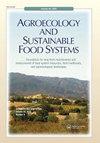利用高光谱图像对牛油果进行分类
IF 2.6
3区 农林科学
Q1 AGRICULTURE, MULTIDISCIPLINARY
Agroecology and Sustainable Food Systems
Pub Date : 2023-04-07
DOI:10.21323/2618-9771-2023-6-1-46-52
引用次数: 0
摘要
本文介绍了在400-1000 nm范围内使用高光谱成像(HSI)和多变量分析方法对哈斯鳄梨果实进行分选。利用主成分分析法对牛油果hsi数据矩阵进行分解。揭示了牛油果果实成熟过程和水分含量与可见光和近红外光谱的相关反射带。已经建立了可视化牛油果内联排序由水分是可能的,当使用因子加载作为伪色。基于牛油果水分测量数据和高光谱图像,建立了牛油果水分和干物质测定的标定模型。光谱数据矩阵采用两种方法组成:从水果的整个表面随机选择hsi的光谱特征,或将水果的hsi图像表面(初始hsi)作为感兴趣区域(ROI)。基于水分测量数据和高光谱图像光谱特征的选择,建立了牛油果水分和干物质检测的标定模型。采用投影隐结构(PLS)序列模拟方法,建立了牛油果成分中水分(RP2 = 0.89)和干物质(RP2 = 0.92)的精确校准模型。通过初始hsi建立标定模型,得到了预测鳄梨果实成分中水分(RС2 = 0.99)和干物质(RС2 = 0.99)的模型。建议使用初始hsi的校准模型,根据现行标准UNECE标准ffv - 42:19 19确定可接受值范围内的水分和干物质。本文章由计算机程序翻译,如有差异,请以英文原文为准。
Avocado fruit sorting by hyperspectral images
The paper shows the use of the methods of hyperspectral imaging (HSI) in a range of 400–1000 nm and multivariate analysis for sorting Hass avocado fruits. The decomposition of the data matrix of HSIs of avocado fruits was carried out using the principle component analysis. The reflection bands in the visible and near-infrared spectral regions interrelated with the process of maturation and the moisture content of avocado fruits were revealed. It has been established that visualization upon avocado inline sorting by moisture is possible when using factor loadings as pseudo-color. Calibration models for determination of moisture and dry matter of avocado fruits were built based on the data of moisture measurement and hyperspectral images. The matrix of spectral data was formed by two methods: random selection of spectral signatures of HSIs from the whole surface of fruits or the image surface of HSIs of fruits (initial HSIs) as a region of interest (ROI). Based on the data of moisture measurement and selection of spectral signatures of hyperspectral images, calibration models were built for detection of moisture and dry matter of avocado fruits. Using sequential simulation by the projection to latent structures (PLS) method, accurate calibration models were developed to detect moisture (RP2 = 0.89) and dry matter (RP2 = 0.92) in the composition of avocado fruits. When building calibration models by the initial HSIs, models were obtained to predict moisture (RС2 = 0.99) and dry matter (RС2 = 0.99) in the composition of avocado fruits. It is proposed to use calibration models by the initial HSIs to determine moisture and dry matter in the intervals of the acceptable values according to the acting standard UNECE STANDARD FFV-42:2019.
求助全文
通过发布文献求助,成功后即可免费获取论文全文。
去求助
来源期刊

Agroecology and Sustainable Food Systems
AGRICULTURE, MULTIDISCIPLINARY-GREEN & SUSTAINABLE SCIENCE & TECHNOLOGY
CiteScore
4.80
自引率
7.70%
发文量
73
期刊介绍:
Agroecology and Sustainable Food Systems is devoted to the rapidly emerging fields of agroecology and food system sustainability. By linking scientific inquiry and productive practice with transformative social action, agroecology provides a foundation for developing the alternative food systems of the future. The journal focuses on the changes that need to occur in the design and management of our food systems in order to balance natural resource use and environmental protection with the needs of production, economic viability, food security, and the social well-being of all people.
Agroecology and Sustainable Food Systems examines our current food systems from production to consumption, and the urgent need to transition to long-term sustainability. The journal promotes the study and application of agroecology for developing alternatives to the complex problems of resource depletion, environmental degradation, a narrowing of agrobiodiversity, continued world hunger, consolidation and industrialization of the food system, climate change, and the loss of farm land. The journal uses a food systems approach, and seeks experiences in agroecology that are on-farm, participatory, change-oriented, and backed by broad-based methodologies of sustainability analysis and evaluation.
 求助内容:
求助内容: 应助结果提醒方式:
应助结果提醒方式:


